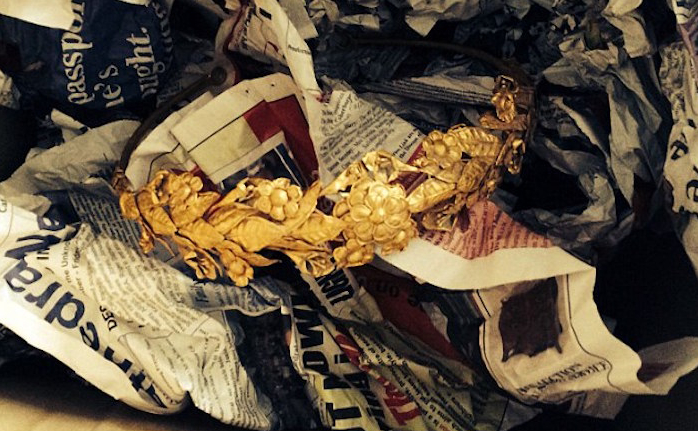An incredibly rare gold crown estimated to be more than 2,000 years old was found in a tattered cardboard box under a retiree’s bed in England.

a bed in a Somerset cottage [Credit: Dukes/BNPS]
The elderly man— who wants to remain anonymous— says he inherited it from his grandfather and had put it away with other “stuff” he had accumulated over the years.
The perfectly preserved gold wreath, used in Ancient Greece to crown athletic and artistic competitions, as well as in religious ceremonies, could be worth more than $200,000, according to auctioneers who plan to put the item up for sale.
According to Guy Schwinge, the auctioneer who was invited to the man’s house to have a look at items he wanted to auction, “It is notoriously difficult to date gold wreaths of this type. Stylistically it belongs to a rarefied group of wreaths dateable to the Hellenistic period and the form may indicate that it was made in Northern Greece. It is eight inches across and weighs about 100 grams. It’s pure gold and handmade, it would have been hammered out by a goldsmith.”

[Credit: Phil Yeomans/BNPS]
Gold wreaths like the one found were meant to imitate the wreaths of real leaves that were worn in Ancient Greece in religious ceremonies and given as prizes in athletic and artistic contests.
They usually depicted branches of laurel, myrtle, oak and olive trees, which were symbolic of concepts such as wisdom, triumph, fertility, peace and virtue.
Due to their fragile nature, they were only worn on very special occasions. Many were dedicated to the Gods in sanctuaries or placed in the graves of royal or aristocratic people as funerary offerings.

Bits of dirt embedded on the wreath suggest this one was buried at some point, according to London’s Daily Mail, which first reported on the find.
Most date to the Hellenistic period (323BC to 31BC), which this one is also thought to date from, and show the exceptional skill of goldsmiths at that time.
Some were made during earlier periods but the wreaths became more frequent after Alexander the Great’s Eastern conquests, when gold was more available in Greece.

[Credit: Phil Yeomans/BNPS]
The current owner’s grandfather was a great collector who was fascinated by archaeology and the ancient world.
Although his family do not know how he acquired it, it is likely he bought it sometime in the 1940s when he travelled extensively.
The man said: ‘I knew my grandfather travelled extensively in the 1940s and 50s and he spent time in the north west frontier area, where Alexander the Great was, so it’s possible he got it while he was there. But he never told me anything about this wreath.”
“I inherited quite a lot of things from him and I just put this to one side for almost a decade and didn’t really think anything of it. Recently I decided I needed to sort through things and called in Duke’s (auctioneers) to have look at some of the items he’d passed on to me.”
Author: Gregory Pappas | Source: The Pappas Post [May 28, 2016]